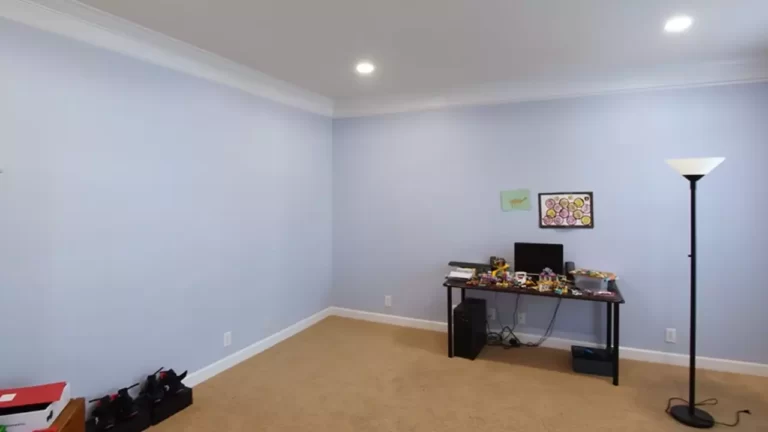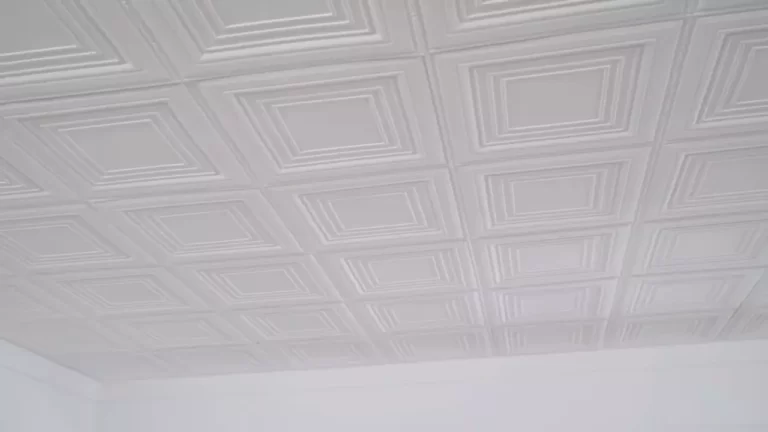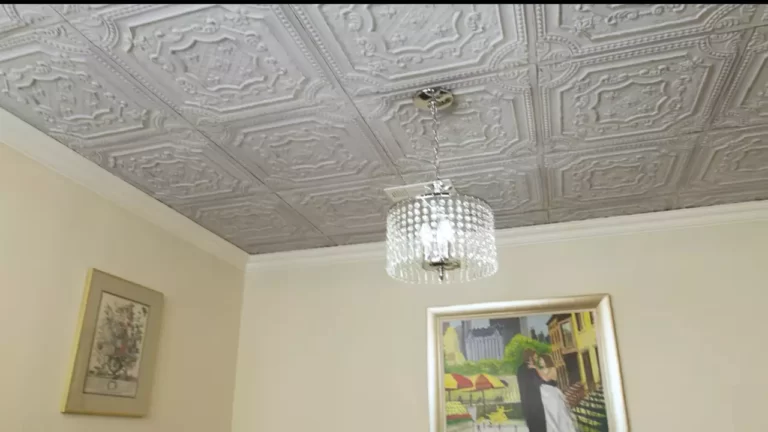How to Install Insulation in Ceiling?
To install insulation in the ceiling, measure and cut the insulation to fit between the ceiling joists, ensuring a snug and secure fit. Gently press the insulation into place, avoiding any compression that could reduce its effectiveness.
Finally, cover the insulation with a vapor barrier to prevent moisture buildup. Insulating your ceiling is an important step in creating a comfortable living environment and improving energy efficiency. Proper insulation helps to regulate indoor temperature, reduce noise, and lower heating and cooling costs.
Whether you’re insulating a new construction or upgrading an existing ceiling, this guide will provide you with step-by-step instructions on how to install insulation in the ceiling. By following these guidelines, you can effectively enhance the insulation of your ceiling, resulting in a more comfortable and energy-efficient home.
The Benefits Of Having Insulation In The Ceiling
When it comes to improving the energy efficiency and comfort of your home, installing insulation in the ceiling is a highly effective solution. Not only does it provide insulation from temperature changes, but it also offers several other benefits that can enhance your living space. In this article, we will explore the top advantages of having insulation in the ceiling, including energy efficiency and cost savings, improved indoor comfort, and reduction in noise transfer.

Energy efficiency and cost savings
Insulation in the ceiling acts as a barrier that prevents the transfer of heat between the interior and exterior of your home. By effectively regulating the temperature, it reduces the need for excessive heating or cooling systems. This, in turn, leads to significant energy savings and a noticeable reduction in utility bills. With proper insulation, your home can maintain a comfortable temperature year-round without relying heavily on artificial heating or cooling methods. Investing in ceiling insulation today can result in long-term cost savings and contribute to a more sustainable environment for future generations.
Improved indoor comfort
A properly insulated ceiling can greatly enhance the comfort of your living space. During hot summer months, insulation helps keep the interior cool by preventing the entry of external heat. Likewise, in colder seasons, it traps the warmth inside, creating a cozy and comfortable environment. By maintaining a consistent temperature, ceiling insulation eliminates drafts and reduces temperature fluctuations, ensuring that you and your family can enjoy a comfortable living space throughout the year. Whether it’s for work, relaxation, or family time, a well-insulated ceiling creates an ideal indoor atmosphere that promotes well-being and happiness.
Reduction in noise transfer
Aside from temperature regulation benefits, insulation in the ceiling also plays a crucial role in reducing noise transfer. It acts as a sound buffer, absorbing and dampening external noises from entering your home. Whether it’s traffic sounds, barking dogs, or noisy neighbors, a well-insulated ceiling can significantly reduce noise levels, creating a quieter and more peaceful indoor environment.
This is especially important for those living in busy urban areas or near busy streets, where outside noise pollution can be a major hindrance to daily activities and relaxation. With ceiling insulation, you can enjoy a tranquil living space free from disruptive sounds, allowing you to fully unwind and rejuvenate.
In conclusion, the benefits of having insulation in the ceiling go beyond just energy efficiency. With proper insulation, your home can become an oasis of comfort and tranquility. The energy savings, improved indoor comfort, and reduction in noise transmission make it a worthwhile investment that can enhance the overall quality of your living space. Say goodbye to high utility bills, temperature fluctuations, and intrusive noises by considering ceiling insulation for your home.
Factors To Consider When Choosing Insulation Materials
When it comes to installing insulation in your ceiling, choosing the right materials is crucial. Insulation not only helps to regulate the temperature in your home, but it also plays a key role in energy efficiency and overall comfort. Here are some important factors to consider when selecting insulation materials:
R-value and thermal conductivity
The R-value of insulation measures its ability to resist heat flow. It is a crucial factor to consider when choosing insulation materials. Higher R-values indicate better insulation performance, meaning the material is more effective at preventing heat transfer. Thermal conductivity, on the other hand, measures how well a material conducts heat. It is the reciprocal of the R-value, with lower thermal conductivity indicating better insulation.
Moisture resistance
Moisture resistance is another important consideration when selecting insulation materials. Moisture can degrade the performance of insulation over time and lead to issues such as mold and mildew growth. It is essential to choose insulation that has excellent moisture resistance properties to ensure its longevity and effectiveness.

Fire resistance and safety
Fire resistance is a critical factor, especially when installing insulation in the ceiling. Insulation materials should have a high fire resistance rating to reduce the risk of fire spread. Select materials that are fire-resistant and comply with relevant safety standards to ensure the safety of your home and loved ones.
Environmental impact and sustainability
The environmental impact and sustainability of insulation materials are becoming increasingly important factors in the decision-making process. Choosing insulation that has minimal impact on the environment and is made from renewable or recycled materials can help reduce your carbon footprint. Consider materials that are energy-efficient to manufacture and have a long lifespan to minimize waste.
Common Insulation Materials Used In Ceilings
When it comes to insulating your ceiling, there are several common materials to choose from. Each material has its own advantages and considerations. In this blog post, we will explore the most widely used insulation materials for ceilings and discuss their benefits.
Fiberglass Insulation
One of the most popular choices for ceiling insulation is fiberglass. Made from tiny glass fibers, this insulation material comes in rolls or batts and is relatively easy to install. The glass fibers trap air, reducing heat transfer and keeping your home comfortable.
Benefits of fiberglass insulation for ceilings include:
- Excellent thermal insulation properties
- Offers soundproofing qualities
- Non-combustible and fire-resistant
- Cost-effective option
Keep in mind that fiberglass insulation can cause skin irritation, so proper protective gear should be worn during installation.
Cellulose Insulation
Cellulose insulation is an eco-friendly option made from recycled newspaper treated with flame retardants. It can be blown into the ceiling cavity, filling gaps efficiently. This material is advantageous for its thermal performance and soundproofing abilities.
The benefits of cellulose insulation for ceilings are:
- Excellent thermal and sound insulation
- Reduces energy consumption and lowers utility bills
- Environmentally friendly, made from recycled materials
- Resistant to pests and mold
It’s important to note that cellulose insulation can settle over time, leading to a decrease in its effectiveness. Regular inspection and maintenance can help maintain its performance.

Mineral Wool Insulation
Mineral wool insulation, also known as rock wool, is made from natural minerals such as basalt or diabase. It is available in batts or loose-fill form, making it suitable for different ceiling structures. Mineral wool has exceptional fire resistance properties, making it an ideal choice for safety-conscious homeowners.
Benefits of mineral wool insulation for ceilings include:
- High fire resistance
- Provides excellent thermal and acoustic insulation
- Moisture-resistant
- Non-combustible and doesn’t promote the spread of flames
While mineral wool insulation offers superior fire resistance, it can be more expensive compared to other materials. However, the long-term benefits outweigh the initial investment.
Spray Foam Insulation
Spray foam insulation is a versatile option that expands upon application, filling every nook and cranny in the ceiling cavity. It can effectively seal air leaks, providing superior thermal insulation. However, it requires professional installation due to its technical requirements.
The benefits of spray foam insulation for ceilings are:
- Excellent thermal insulation and air-sealing properties
- Prevents mold growth and moisture infiltration
- Enhances the structural integrity of the ceiling
- Reduces energy consumption and lowers utility bills
Due to its cost and complexity, spray foam insulation may not be suitable for every budget or DIY project. Consulting with a professional insulation contractor is recommended.
Frequently Asked Questions Of How To Install Insulation In Ceiling
How Do You Install Insulation In An Attic Ceiling?
To install insulation in an attic ceiling, follow these steps:
1. Ensure safety by wearing protective clothing and a mask.
2. Measure the area accurately and calculate the amount of insulation needed.
3. Lay insulation between the ceiling joists, starting from the outer edges and working inwards.
4. Use a utility knife to trim the insulation to fit perfectly.
5. Cover the insulation with a vapor barrier to prevent moisture buildup.
Do You Staple Insulation In Ceiling?
Yes, insulation can be stapled in the ceiling.
What Kind Of Insulation Do You Use On A Ceiling?
We use various types of insulation for ceilings, such as fiberglass, cellulose, and foam. Each type offers different benefits, like energy efficiency and soundproofing. Our experts can help you determine the best insulation for your specific ceiling needs.
Can I Install Ceiling Insulation Myself?
Yes, you can install ceiling insulation yourself.
Conclusion
Installing insulation in the ceiling is a vital step in creating a comfortable and energy-efficient home. By following the steps mentioned in this guide, you can ensure that your ceiling is well-insulated and protected against temperature fluctuations and noise. Remember to choose the right type of insulation for your specific needs and to follow safety precautions during the installation process.
With proper insulation, you can enjoy a cozy home and save on energy costs.







